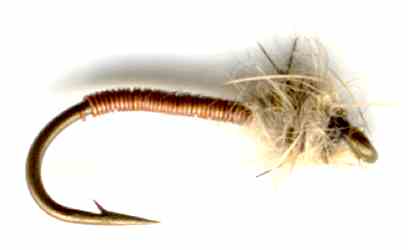The Brassie Nymph Fly
Brassies catch fish. The copper wire body gets the nymph to the bottom and the attractive silhouette is enough to suggest to a trout this is food.

BRASSIE NYMPH FLY. Hook size 14 16 18 20- $US each
I have used these nymphs in still and moving water with good success. The copper wire body gets the nymph to the bottom. The attractive silhouette, the flash of the copper, the moving leg like strands of dubbing and the segmentation is enough to suggest to a trout, this is food. After a few hours with a fly rod you understand the necessity for adding weight to small flies. Trout tend to feed on midge larva and nymphs near the streambed. We all know that fish also look for emerging pupae as they float to the surface but consistent angling results rests in getting your flies to where the hungry fish look for their next meal, most of the time and that is near the bottom. To do this you need flies that sink. This isn't as easy as it sounds for the small fly enthusiast. You need a small fly that will brake the tension on the water surface. Just adding lots of heavy dubbing does not work. The thin heavy wire profile cuts through the surface film.
Why is it called a Brassie when there is no brass used in its construction? When it was first developed brass plated wire was used but it is no longer in production. Fly tiers moved to using a more modern, easily available material, copper wire. It is said to have been developed in the 1960's for use in Colorado's South Platte River. Who invented it? Ken Chandler, Tug Davenport and Gene Lynch collaborated in using flies with copper wire bodies around that time. There are lots of variations all with named designers claiming the fly for themselves. This nymph is a general purpose fly. It suggests food and doesn't try to imitate a specific insect. Some say it is a cased caddis that has rolled in iron pyrite sand to build it's home but in my opinion that is garbage. It is just a great nymph that works. If the trout like it as I know they do from numerous successes, I like it.
GOOGLE+ READER'S COMMENT
I use these Brassie nymph fly patterns in both copper and brass wire. But also with peacock her or muskrat spikey! They really work well for me deep. - Mike Beaver, USA


Fly Fishing books

